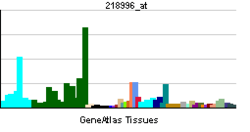TFPT
TCF3 fusion partner is a protein that in humans is encoded by the TFPT gene.[4][5][6]
References
- ↑ "Diseases that are genetically associated with TFPT view/edit references on wikidata".
- ↑ "Human PubMed Reference:".
- ↑ "Mouse PubMed Reference:".
- ↑ Irie Y, Yamagata K, Gan Y, Miyamoto K, Do E, Kuo CH, Taira E, Miki N (Feb 2000). "Molecular cloning and characterization of Amida, a novel protein which interacts with a neuron-specific immediate early gene product arc, contains novel nuclear localization signals, and causes cell death in cultured cells". J Biol Chem. 275 (4): 2647–2653. doi:10.1074/jbc.275.4.2647. PMID 10644725.
- ↑ Jin J, Cai Y, Yao T, Gottschalk AJ, Florens L, Swanson SK, Gutierrez JL, Coleman MK, Workman JL, Mushegian A, Washburn MP, Conaway RC, Conaway JW (Dec 2005). "A mammalian chromatin remodeling complex with similarities to the yeast INO80 complex". J Biol Chem. 280 (50): 41207–41212. doi:10.1074/jbc.M509128200. PMID 16230350.
- ↑ "Entrez Gene: TFPT TCF3 (E2A) fusion partner (in childhood Leukemia)".
Further reading
- Jiang F, Ai J, Xiao W, Wang Z (2007). "FB1, an E2A fusion partner in childhood leukemia, interacts with U19/EAF2 and inhibits its transcriptional activity". Cancer Lett. 253 (2): 265–272. doi:10.1016/j.canlet.2007.02.003. PMC 1989770
 . PMID 17395368.
. PMID 17395368.
- Olsen JV, Blagoev B, Gnad F, et al. (2006). "Global, in vivo, and site-specific phosphorylation dynamics in signaling networks". Cell. 127 (3): 635–648. doi:10.1016/j.cell.2006.09.026. PMID 17081983.
- Franchini C, Fontana F, Minuzzo M, et al. (2007). "Apoptosis promoted by up-regulation of TFPT (TCF3 fusion partner) appears p53 independent, cell type restricted and cell density influenced". Apoptosis. 11 (12): 2217–2224. doi:10.1007/s10495-006-0195-5. PMID 17041757.
- Rual JF, Venkatesan K, Hao T, et al. (2005). "Towards a proteome-scale map of the human protein-protein interaction network". Nature. 437 (7062): 1173–1178. doi:10.1038/nature04209. PMID 16189514.
- Gerhard DS, Wagner L, Feingold EA, et al. (2004). "The status, quality, and expansion of the NIH full-length cDNA project: the Mammalian Gene Collection (MGC)". Genome Res. 14 (10B): 2121–2127. doi:10.1101/gr.2596504. PMC 528928
 . PMID 15489334.
. PMID 15489334.
- Strausberg RL, Feingold EA, Grouse LH, et al. (2003). "Generation and initial analysis of more than 15,000 full-length human and mouse cDNA sequences". Proc. Natl. Acad. Sci. U.S.A. 99 (26): 16899–16903. doi:10.1073/pnas.242603899. PMC 139241
 . PMID 12477932.
. PMID 12477932.
- Brambillasca F, Mosna G, Colombo M, et al. (1999). "Identification of a novel molecular partner of the E2A gene in childhood leukemia". Leukemia. 13 (3): 369–375. doi:10.1038/sj/leu/2401338. PMID 10086727.

 . PMID 17395368.
. PMID 17395368. . PMID 15489334.
. PMID 15489334. . PMID 12477932.
. PMID 12477932.